AHDB’s Crop Protection Scientist, Charlotte Rowley, assesses new methods of control against slugs in the face of the
industry losing metaldehyde.

Following the announcement from Defra on the withdrawal of metaldehyde in 2020, thoughts are again turning towards slug management. The good news is that there is an effective alternative: ferric phosphate has been shown to be as effective as metaldehyde in controlling slugs. Unlike metaldehyde, slugs die underground rather than on the surface, meaning it may not be as obvious when an application has been effective. The bigger issue, apart from differences in product cost, is that relying on only one active ingredient leaves the industry in a vulnerable position when it comes to slug management. Now more than ever it is important to use every tool in the armoury to ensure that molluscicide applications are kept to a minimum.
Using cultivation as a control
Cultivation is generally regarded as one of the more effective forms of cultural control, therefore no-till farmers may be more concerned than most. It’s important to remember though that there is no silver bullet for slug management, and a whole system approach is needed. So while cultivation is bad news for slugs, it can also be bad news for predatory ground beetles that help keep slug populations in check. Ground beetles, as the name suggests, forage and hunt for their food on the soil surface and have soil dwelling larvae, and therefore tend to be vulnerable to soil disturbance. Keeping pesticide use to a bare minimum and providing habitat in the form of diverse field margins will also help maintain numbers of these beetles and other natural enemies.
Cover crops have a role to play
Cover crops can provide much needed habitat for beneficial insects, however they have a bad reputation when it comes to slugs. It is often reported that cover crops make slug damage worse, creating a sheltered, moist, food-rich habitat that slugs love. However, research suggests that the type of cover crop can make a huge difference when it comes to slug pressure, with some crops such as ryegrass thought to be less attractive to slugs due to the high silicone content of the leaves. There are other insects too that are benefitted by increasing plant diversity, and while they may not feed on slugs directly, they provide food to support populations of slug-eating birds and carabids.
What can the farmer do to help?
However, as helpful as they are ground beetles cannot do all of the hard work. This is where farmer intervention is needed to get the crop off to a good start. A fine, consolidated seedbed (e.g. through rolling) means that the seed is more inaccessible to slugs and helps get the crop established and able to grow away from damage. Anecdotally, some farmers have had success protecting their wheat from seed hollowing by sowing it directly into the stubble of the previous oilseed rape crop, allowing the volunteers to act as a trap crop until the wheat is no longer vulnerable to attack. Other farmers report that raking of straw and crop debris can reduce the risks of slug damage in minor no-till environments. This might work by exposing slugs and their eggs to the sunlight, drying them out and making them more accessible to predators, as well as reducing the number of damp hiding places on the soil surface.
What we know and what happens next?
As for oilseed rape crops, we know from work on cabbage stem flea beetle that the plants can be extremely resilient to damage and establishment is key. A DEFRA-funded desk study done by ADAS in 2014 suggested that for OSR sown at 60 seeds/m2 a single dose of metaldehyde only became cost effective at moderate slug pressures (where 30- 50% of plants were expected to be lost). Where pellets are more expensive (as with ferric phosphate) or slug pressure is lower, it might make more economic sense to instead increase seed rate to mitigate against slug damage. While this doesn’t take into account further losses from e.g. pigeon damage, it demonstrates the ability of the crop to compensate for losses. Unfortunately for farmers, slugs tend to congregate in patches which can lead to an uneven distribution of damage, making crop compensation less effective.
AHDB PhD student Emily Forbes, at Harper Adams University, has been modelling these patches in the hope that this will lead to the ability to target control options more effectively. “My PhD project has identified and confirmed the potential for patch treatment of slugs” said Emily, “further work is required to refine the methods for locating the patches without the requirement for trapping in order to make the findings commercially viable”. Her report, due this spring, will shed light on some of the slug behaviours leading to patch formation. Other research to look out for this year will be from AHDB’s Nuffield scholar Jenna Ross who has been travelling the world learning about slug and snail management in other countries, in a range of agricultural and horticultural systems. Both of these projects will help push towards improving or increasing the current range of control strategies which will be essential if we are to have effective and sustainable slug management in the future.
For further information, please visit:
cereals.ahdb.org.uk/crop-management/
pest-management.aspx
Or to download our slug control factsheet: ahdb.org.uk/knowledgelibrary/integrated-slug-control
KEY SLUG SPECIES
The grey field slug (Deroceras reticulatum) and other Deroceras spp.
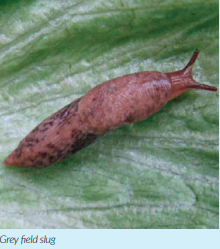
The grey field slug is the most widespread and troublesome species. It is usually light grey or brown, grows to 5 cm in length and produces milky white mucus. Populations tend to have a mixed age structure, so damage occurs whenever conditions are favourable for activity. It continues to be active in damp weather and even when temperatures are close to freezing. Breeding is generally at a peak in April and May and then again from September to October. However, in favourable conditions, it will breed throughout the year. In optimum conditions it can start to lay eggs within 16 weeks of hatching.
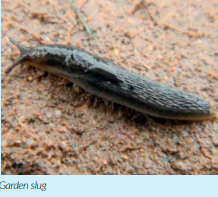
The garden slug (Arion hortensis and Arion distinctus)
The garden slug is usually smaller than the grey field slug, growing to 3 cm in length. The body is dark and the foot (underside) ranges from yellow to orange. It produces orange or yellow mucus. Egg hatching reaches its peak in late spring/early summer. Young slugs can develop rapidly to produce a further generation within the year. Arion species are only active at temperatures above 5°C and are less active on the soil surface than the grey field slug.
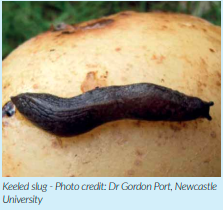
The keeled slug (Milax,Tandonia and Boettgerilla spp.)
Keeled slugs are more localised in arable crops than field or garden slugs but they can be important. They vary in size and generally produce a colourless mucus. Keeled slugs have annual life cycles, with eggs hatching from autumn to spring. All keeled species are generally subterranean but can be seen on the surface, especially during the breeding season.
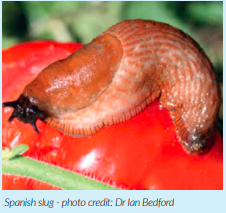
The Spanish slug (Arion vulgaris)
Spanish slugs can be brown, black, fawn or mustard coloured and can grow up to 15 cm long. Unlike other slug species, the Spanish slug is omnivorous, eating dead animals, excrement and plant material. They produce twice as many eggs as native slug species.
LIFE CYCLE
All slug species are hermaphrodite (each individual is both male and female). While some species are self-fertile, most mate before laying eggs in batches of 10 to 50 in soil cavities, between clods, under stones or at the base of plants. Up to 500 eggs per slug may be laid over several weeks. Eggs develop slowly in the winter but will hatch within a few weeks when the temperature starts to rise. The number of active slugs found at any one time and place is dictated by both the slug population density and the suitability of the weather for activity (activity-density). Rapid reproduction and growth is enhanced by mild, moist weather conditions, sufficient food supply and ample shelter. Such conditions prevail in the spring and early autumn, making crops like lettuce and Brassicas more vulnerable at these times of year. Slug movement occurs most frequently at night but they will return to their resting site by dawn if weather conditions are unfavourable. They do not travel far from where they were hatched, often taking only a circular route of a few metres in search of food..
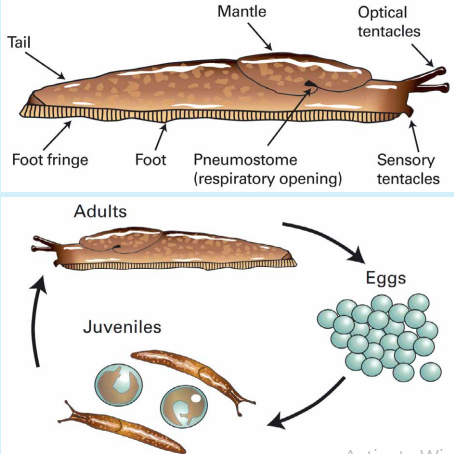
MONITORING FOR SLUGS
To assess the risk of crop damage, it is important to estimate the size of slug populations present. Sampling in the field is best done using refuge traps. Put slug traps out before cultivation, when the soil surface is visibly moist and the weather is mild (5–25°C). When soil conditions are dry and slugs are not actively seeking food, trapping will have little value in determining the threat to the crop. Traps consist of a cover about 25 cm across, such as a plant pot saucer, with a small heap of bait underneath.

A suitable bait would be two heaped spoonfuls of chicken layers’ mash or a cereal grain-based food (NOT slug pellets). Leave a small gap between the trap and the soil to allow slugs to enter. It may be necessary to put a weight on the trap in windy conditions. In each field, nine traps (13 in fields larger than 20 ha) should be set out in a ‘W’ pattern spread over the entire area of the field. Also, concentrate on areas known to suffer damage. In standing crops, place the traps just to the side of tramlines and mark with canes to allow them to be located.
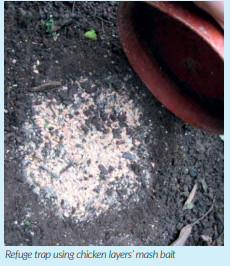
Leave traps overnight and examine early the following morning while the soil surface is still moist, counting the number of slugs present and noting any slime trails. On warm days, it is important to check the traps early while the temperature is still cool, as slugs will leave the trap as it gets warmer. If no slugs are found, continue to trap until crops have passed their vulnerable stage. The following (Table 1) thresholds indicate a possible risk when soil and weather conditions favour slug activity.
